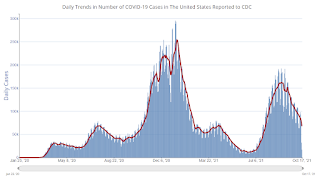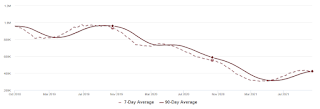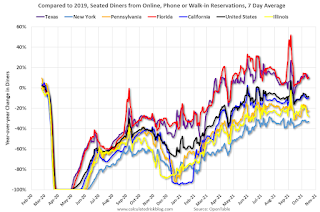by Calculated Risk on 10/18/2021 05:22:00 PM
Monday, October 18, 2021
4th Look at Local Housing Markets in September; Adding Austin, California, Des Moines, Houston and Maryland
Today, in the Newsletter: 4th Look at Local Housing Markets in September
Excerpt:
Inventory in San Diego is at an all time low, whereas inventory in Denver and Sacramento is up more than double from the all time low earlier this year.
Austin and Sacramento are two of the few areas with inventory up YoY. The C.A.R. reported today that inventory in 40% of the markets in California are either unchanged or up year-over-year. This is a change.
MBA Survey: "Share of Mortgage Loans in Forbearance Decreases to 2.28%"
by Calculated Risk on 10/18/2021 04:00:00 PM
Note: This is as of October 10th.
From the MBA: Share of Mortgage Loans in Forbearance Decreases to 2.28%
The Mortgage Bankers Association’s (MBA) latest Forbearance and Call Volume Survey revealed that the total number of loans now in forbearance decreased by 34 basis points from 2.62% of servicers’ portfolio volume in the prior week to 2.28% as of October 10, 2021. According to MBA’s estimate, 1.1 million homeowners are in forbearance plans.
The share of Fannie Mae and Freddie Mac loans in forbearance decreased 16 basis points to 1.05%. Ginnie Mae loans in forbearance decreased 17 basis points to 2.77%, and the forbearance share for portfolio loans and private-label securities (PLS) declined 108 basis points to 5.34%. The percentage of loans in forbearance for independent mortgage bank (IMB) servicers decreased 25 basis points relative to the prior week to 2.57%, and the percentage of loans in forbearance for depository servicers decreased 53 basis points to 2.16%.
“Forbearance exits continued at an even more robust pace, resulting in a 34 basis-point decline in the overall forbearance rate. The decline was apparent across all servicer types and investor types,” said Mike Fratantoni, MBA’s Senior Vice President and Chief Economist. “There was a substantial drop of over 1 percentage point in the forbearance rate for portfolio and PLS loans, which includes loans held for investment purposes, loans serviced for private investors, and government loans that were bought out of Ginnie Mae pools for the purposes of modifying them and then re-securitizing them into Ginnie Mae pools.”
Added Fratantoni, “We are now down to 1.1 million homeowners in forbearance from a peak of 4.3 million homeowners in June 2020. Positive employment and wage prospects, continued home-price appreciation, and the availability of multiple loan workout options are factors that will smooth many homeowners’ transition out of forbearance.”
emphasis added
 Click on graph for larger image.
Click on graph for larger image.This graph shows the percent of portfolio in forbearance by investor type over time. Most of the increase was in late March and early April 2020, and has trended down since then.
The MBA notes: "Total weekly forbearance requests as a percent of servicing portfolio volume (#) decreased relative to the prior week: from 0.05% to 0.04%."
October 18th COVID-19: Data Released On Monday is Always Low and Revised Up
by Calculated Risk on 10/18/2021 03:20:00 PM
| COVID Metrics | ||||
|---|---|---|---|---|
| Today | Week Ago | Goal | ||
| Percent fully Vaccinated | 57.0% | 56.4% | ≥70.0%1 | |
| Fully Vaccinated (millions) | 189.1 | 187.4 | ≥2321 | |
| New Cases per Day3 | 67,763 | 91,262 | ≤5,0002 | |
| Hospitalized3 | 50,750 | 60,078 | ≤3,0002 | |
| Deaths per Day3 | 1,093 | 1,350 | ≤502 | |
| 1 Minimum to achieve "herd immunity" (estimated between 70% and 85%). 2my goals to stop daily posts, 37 day average for Cases, Currently Hospitalized, and Deaths 🚩 Increasing 7 day average week-over-week for Cases, Hospitalized, and Deaths ✅ Goal met. | ||||
IMPORTANT: For "herd immunity" most experts believe we need 70% to 85% of the total population fully vaccinated (or already had COVID).
The following 20 states have between 50% and 59.9% fully vaccinated: Pennsylvania at 59.5%, Minnesota, Hawaii, Delaware, Florida, Wisconsin, Nebraska, Iowa, Illinois, Michigan, Kentucky, South Dakota, Texas, Arizona, Kansas, Nevada, Alaska, Utah, North Carolina and Ohio at 51.2%.
Next up (total population, fully vaccinated according to CDC) are Montana at 49.6%, Indiana at 49.3%, Missouri at 49.1%, Oklahoma at 49.0% and South Carolina at 49.0%.
 Click on graph for larger image.
Click on graph for larger image.This graph shows the daily (columns) and 7 day average (line) of positive tests reported.
Housing Inventory Oct 18th Update: Inventory Down Slightly Week-over-week
by Calculated Risk on 10/18/2021 11:58:00 AM
Tracking existing home inventory will be very important this year.

This inventory graph is courtesy of Altos Research.
NAHB: Builder Confidence Increased to 80 in October
by Calculated Risk on 10/18/2021 11:07:00 AM
The National Association of Home Builders (NAHB) reported the housing market index (HMI) was at 80, up from 76 in September. Any number above 50 indicates that more builders view sales conditions as good than poor.
From the NAHB: Strong Demand Boosts Builder Confidence Despite Supply Chain Disruptions
Strong consumer demand helped push builder confidence higher in October despite growing affordability challenges stemming from rising material prices and shortages. Builder sentiment in the market for newly built single-family homes moved four points higher to 80 in October, according to the NAHB/Wells Fargo Housing Market Index (HMI) released today.
“Although demand and home sales remain strong, builders continue to grapple with ongoing supply chain disruptions and labor shortages that are delaying completion times and putting upward pressure on building material and home prices,” said NAHB Chairman Chuck Fowke.
“Builders are getting increasingly concerned about affordability hurdles ahead for most buyers,” said NAHB Chief Economist Robert Dietz. “Building material price increases and bottlenecks persist and interest rates are expected to rise in coming months as the Fed begins to taper its purchase of U.S. Treasuries and mortgage-backed debt. Policymakers must focus on fixing the broken supply chain. This will spur more construction and help ease upward pressure on home prices.”
...
All three major HMI indices posted gains in October. The index gauging current sales conditions rose five points to 87, the component measuring sales expectations in the next six months posted a three-point gain to 84 and the gauge charting traffic of prospective buyers moved four points higher to 65.
Looking at the three-month moving averages for regional HMI scores, the Midwest rose one point to 69, the Northeast held steady at 72, the South and West each remained unchanged at 80 and 83, respectively.
 Click on graph for larger image.
Click on graph for larger image.This graph show the NAHB index since Jan 1985.
This was above the consensus forecast, and a strong reading.
Industrial Production Decreased 1.3 Percent in September
by Calculated Risk on 10/18/2021 09:23:00 AM
From the Fed: Industrial Production and Capacity Utilization
Industrial production fell 1.3 percent in September after moving down 0.1 percent in August; output was previously reported to have risen 0.4 percent in August. In September, manufacturing output decreased 0.7 percent: The production of motor vehicles and parts fell 7.2 percent, as shortages of semiconductors continued to hobble operations, while factory output elsewhere declined 0.3 percent. The output of utilities dropped 3.6 percent, as demand for cooling subsided after a warmer-than-usual August. Mining production fell 2.3 percent.
The lingering effects of Hurricane Ida more than accounted for the drop in mining in September; they also contributed 0.3 percentage point to the drop in manufacturing. Overall, about 0.6 percentage point of the drop in total industrial production resulted from the impact of the hurricane.
Despite the decrease in September, total industrial production rose 4.3 percent at an annual rate for the third quarter as a whole, its fifth consecutive quarter with a gain of at least 4 percent.
At 100.0 percent of its 2017 average, total industrial production in September was 4.6 percent above its year-earlier level. Capacity utilization for the industrial sector fell 1.0 percentage point in September to 75.2 percent, a rate that is 4.4 percentage points below its long-run (1972–2020) average.
emphasis added
 Click on graph for larger image.
Click on graph for larger image.This graph shows Capacity Utilization. This series is up from the record low set in April 2020, but below the level in February 2020 (pre-pandemic).
Capacity utilization at 75.2% is 4.4% below the average from 1972 to 2020. This was well below consensus expectations.
Note: y-axis doesn't start at zero to better show the change.
 The second graph shows industrial production since 1967.
The second graph shows industrial production since 1967.Industrial production decreased in September to 100.0. This is 1.3% below the February 2020 level.
The change in industrial production was well below consensus expectations.
Seven High Frequency Indicators for the Economy
by Calculated Risk on 10/18/2021 08:39:00 AM
These indicators are mostly for travel and entertainment. It will interesting to watch these sectors recover as the pandemic subsides.
The TSA is providing daily travel numbers.
This data is as of October 17th.
 Click on graph for larger image.
Click on graph for larger image.This data shows the 7-day average of daily total traveler throughput from the TSA for 2019 (Light Blue), 2020 (Blue) and 2021 (Red).
The dashed line is the percent of 2019 for the seven day average.
The 7-day average is down 21.4% from the same day in 2019 (78.6% of 2019). (Dashed line)
The second graph shows the 7-day average of the year-over-year change in diners as tabulated by OpenTable for the US and several selected cities.
 Thanks to OpenTable for providing this restaurant data:
Thanks to OpenTable for providing this restaurant data:This data is updated through October 16, 2021.
This data is "a sample of restaurants on the OpenTable network across all channels: online reservations, phone reservations, and walk-ins. For year-over-year comparisons by day, we compare to the same day of the week from the same week in the previous year."
Note that this data is for "only the restaurants that have chosen to reopen in a given market". Since some restaurants have not reopened, the actual year-over-year decline is worse than shown.
Dining picked up for the Labor Day weekend, but declined after the holiday - but might be picking up a little again. The 7-day average for the US is down 8% compared to 2019.
 This data shows domestic box office for each week and the median for the years 2016 through 2019 (dashed light blue).
This data shows domestic box office for each week and the median for the years 2016 through 2019 (dashed light blue). Note that the data is usually noisy week-to-week and depends on when blockbusters are released.
Movie ticket sales were at $147 million last week, down about 12% from the median for the week.
 This graph shows the seasonal pattern for the hotel occupancy rate using the four week average.
This graph shows the seasonal pattern for the hotel occupancy rate using the four week average. The red line is for 2021, black is 2020, blue is the median, dashed purple is 2019, and dashed light blue is for 2009 (the worst year on record for hotels prior to 2020).
This data is through October 2nd. The occupancy rate was down 9.6% compared to the same week in 2019.
Notes: Y-axis doesn't start at zero to better show the seasonal change.
 This graph, based on weekly data from the U.S. Energy Information Administration (EIA), shows gasoline supplied compared to the same week of 2019.
This graph, based on weekly data from the U.S. Energy Information Administration (EIA), shows gasoline supplied compared to the same week of 2019.Blue is for 2020. Red is for 2021.
As of October 8th, gasoline supplied was down 1.8% compared to the same week in 2019.
There have been six weeks so far this year when gasoline supplied was up compared to the same week in 2019 - and consumption is running close to 2019 levels now.
This graph is from Apple mobility. From Apple: "This data is generated by counting the number of requests made to Apple Maps for directions in select countries/regions, sub-regions, and cities." This is just a general guide - people that regularly commute probably don't ask for directions.
There is also some great data on mobility from the Dallas Fed Mobility and Engagement Index. However the index is set "relative to its weekday-specific average over January–February", and is not seasonally adjusted, so we can't tell if an increase in mobility is due to recovery or just the normal increase in the Spring and Summer.
 This data is through October 15th for the United States and several selected cities.
This data is through October 15th for the United States and several selected cities.The graph is the running 7-day average to remove the impact of weekends.
IMPORTANT: All data is relative to January 13, 2020. This data is NOT Seasonally Adjusted. People walk and drive more when the weather is nice, so I'm just using the transit data.
According to the Apple data directions requests, public transit in the 7 day average for the US is at 117% of the January 2020 level.
Here is some interesting data on New York subway usage (HT BR).
 This graph is from Todd W Schneider. This is weekly data since 2015.
This graph is from Todd W Schneider. This is weekly data since 2015. This data is through Friday, October 15th.
Schneider has graphs for each borough, and links to all the data sources.
He notes: "Data updates weekly from the MTA’s public turnstile data, usually on Saturday mornings".
Sunday, October 17, 2021
Sunday Night Futures
by Calculated Risk on 10/17/2021 06:56:00 PM
Weekend:
• Schedule for Week of October 17, 2021
• Will 4% Mortgage Rates "Halt the Housing Market"?
Monday:
• At 9:15 AM ET, The Fed will release Industrial Production and Capacity Utilization for September. The consensus is for a 0.2% increase in Industrial Production, and for Capacity Utilization to increase to 76.5%.
• At 10:00 AM, The October NAHB homebuilder survey. The consensus is for a reading of 76, unchanged from 76 in September. Any number above 50 indicates that more builders view sales conditions as good than poor.
From CNBC: Pre-Market Data and Bloomberg futures S&P 500 and DOW futures are down slightly (fair value).
Oil prices were up over the last week with WTI futures at $83.05 per barrel and Brent at $85.31 per barrel. A year ago, WTI was at $41, and Brent was at $41 - so WTI oil prices are up more than double year-over-year.
Here is a graph from Gasbuddy.com for nationwide gasoline prices. Nationally prices are at $3.31 per gallon. A year ago prices were at $2.14 per gallon, so gasoline prices are up $1.17 per gallon year-over-year.
Will 4% Mortgage Rates "Halt the Housing Market"? Some comments on an interview with Ivy Zelman
by Calculated Risk on 10/17/2021 04:14:00 PM
Today, in the Newsletter: Will 4% Mortgage Rates "Halt the Housing Market"?
Excerpt:
On Friday, Sara Eisen asked: “Do you think this hot housing market gets even hotter?”
And Zelman answered:
"No. I don’t. I think the housing market is already starting to show some moderation. And I think that it is going to become even more evident as rates are starting to back up. And the continued upward pressure on home prices which is not sustainable is really impacting affordability. We are starting to see incentives by builders creep back into the market. And we are seeing resistance by consumers that are really questioning whether or not, not only can they can afford it, and do they really want to buy at the top of the market."
Saturday, October 16, 2021
Newsletter Articles this Week
by Calculated Risk on 10/16/2021 02:11:00 PM
At the Calculated Risk Newsletter this week:
• House Prices to National Average Wage Index
• 3rd Look at Local Housing Markets in September Adding Albuquerque, Atlanta, Colorado, Georgia, Jacksonville, Minnesota, New Hampshire, Portland, and South Carolina
• Will House Prices Increase "a further 16% by the end of 2022"? This note is based on a new Goldman Sachs Forecast
• Mortgage Rates Highest in 6 Months Refinance Activity Will Slow
This will usually be published several times a week, and will provide more in-depth analysis of the housing market.
You can subscribe at https://calculatedrisk.substack.com/ Currently all content is available for free - and some will always be free - but please subscribe!.


